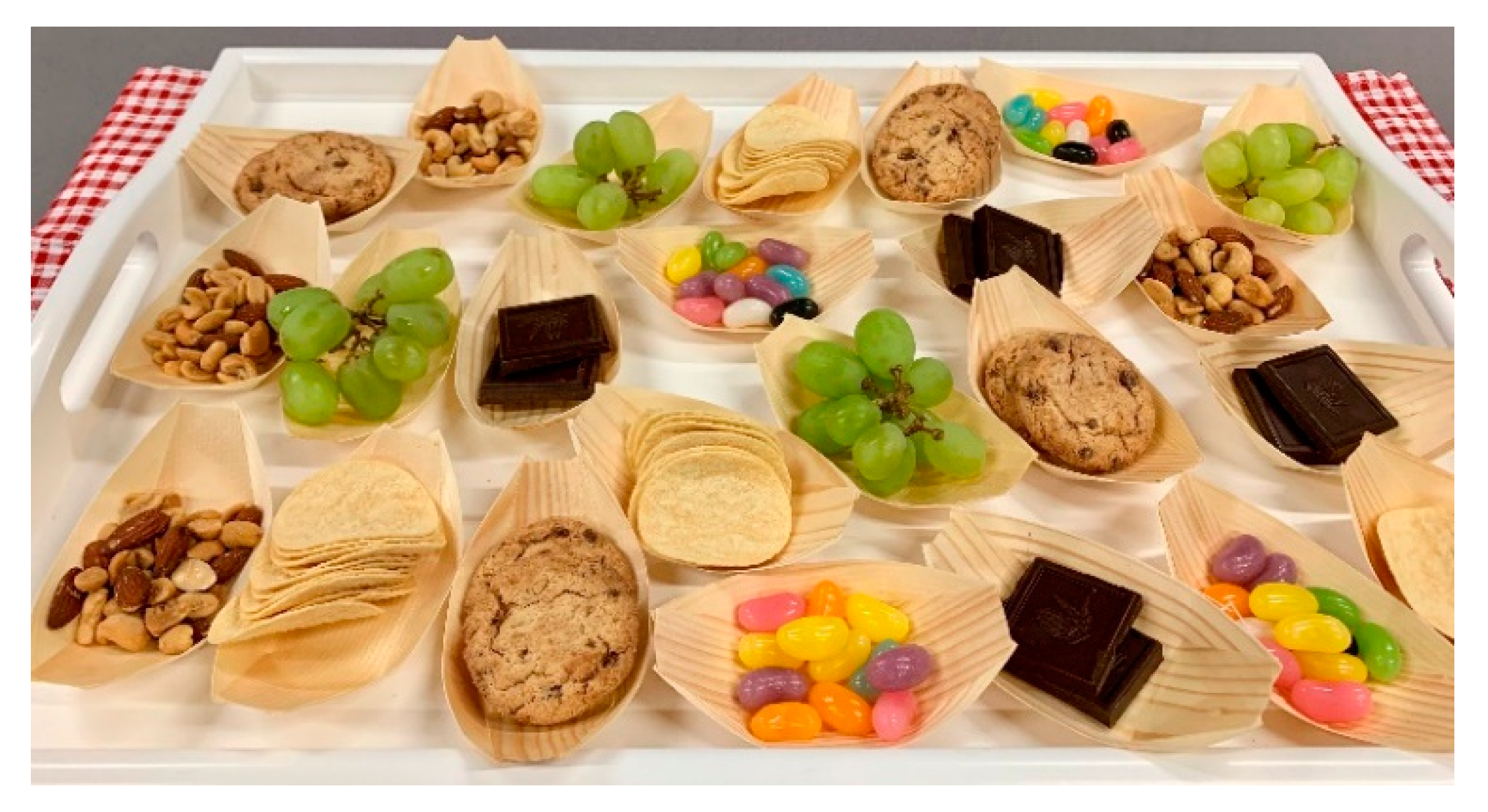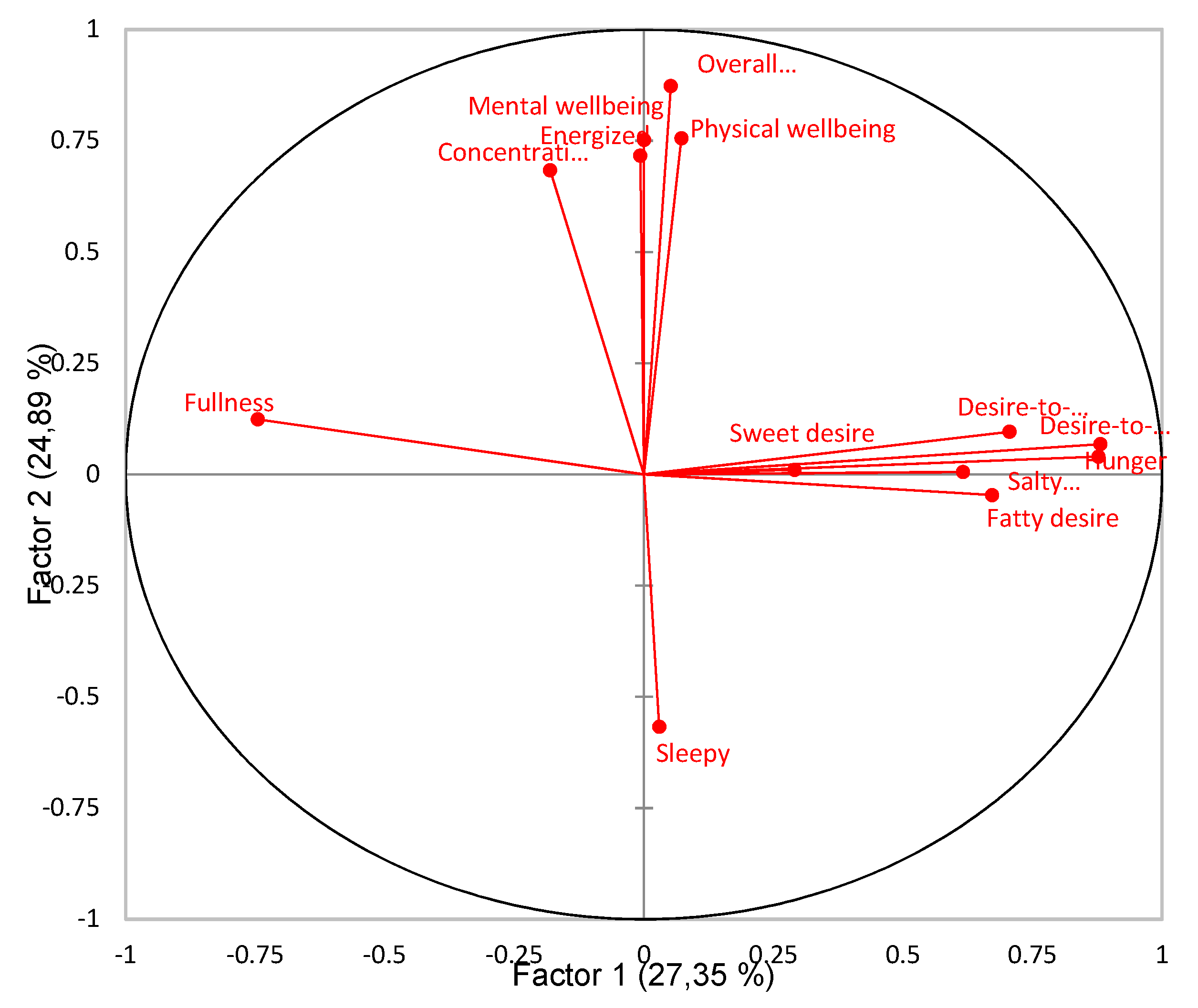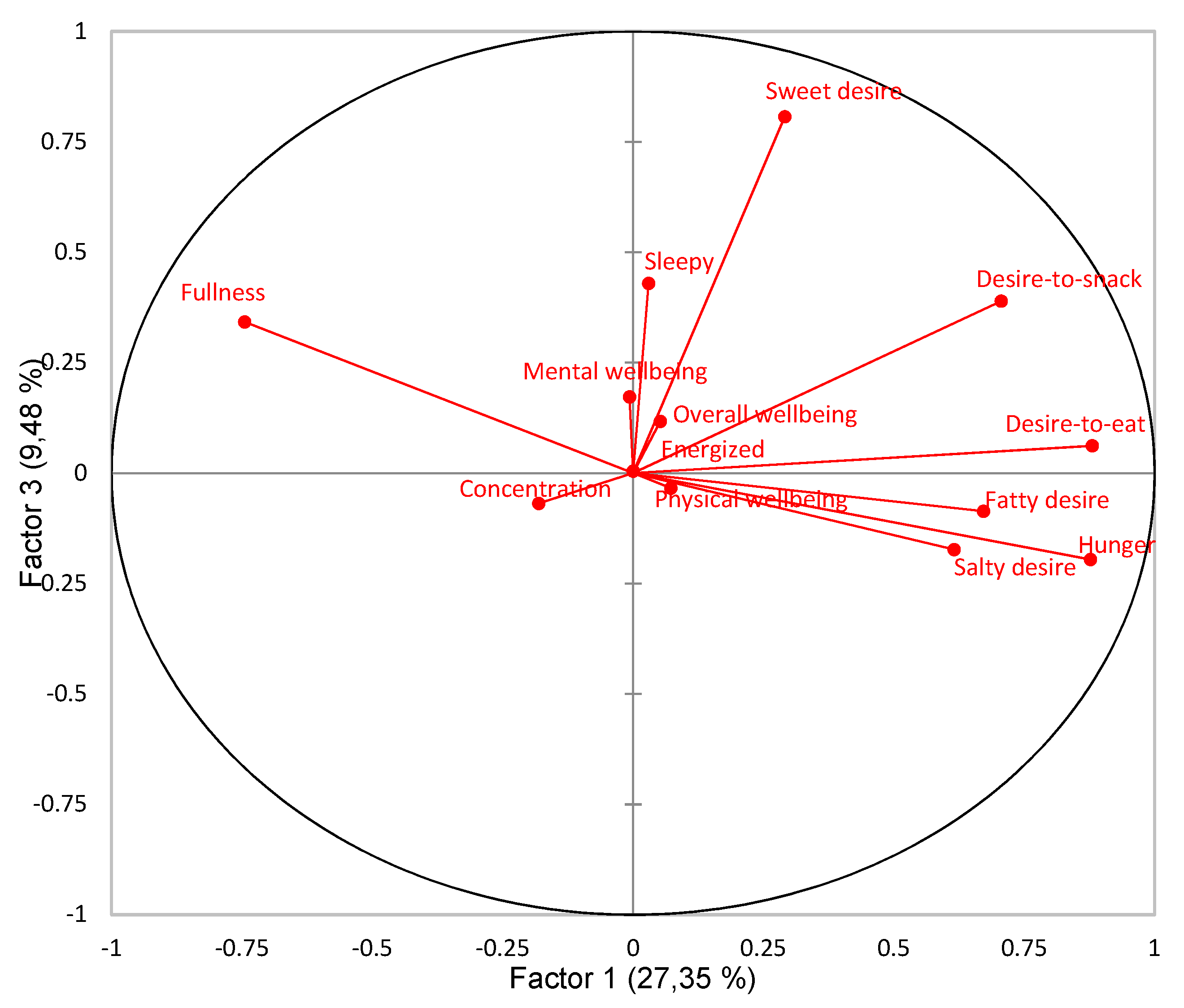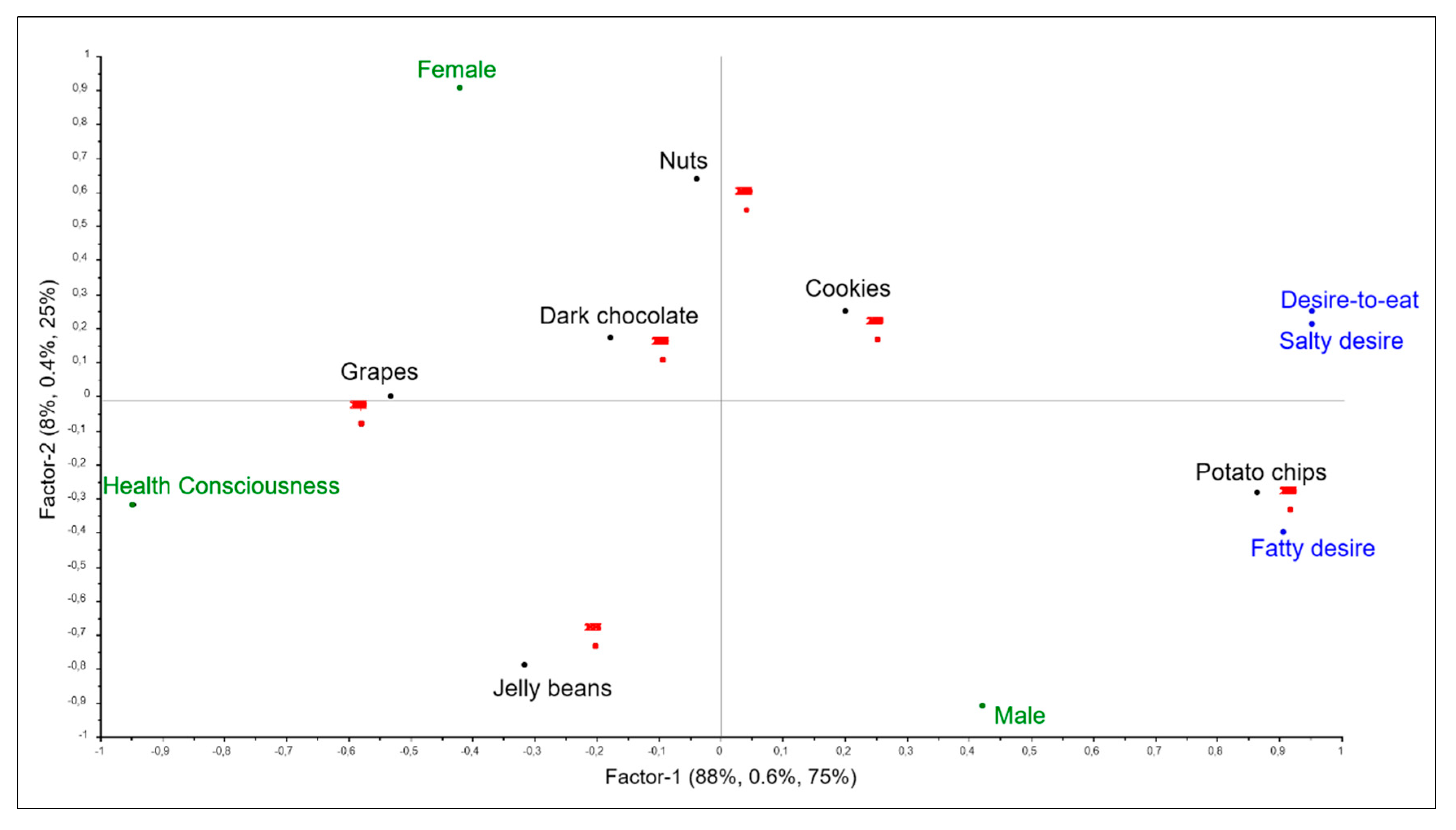Subjective Sensations related to Food as Determinants of Snack Choice
Abstract
1. Introduction
- What subjective temporal sensations contribute to snack choice?
- Do other factors such as gender, time of day and health consciousness affect consumers’ snack choice?
2. Materials and Methods
2.1. Participants, Recruitment and Procedure
2.2. Questionnaire
2.3. Snack Samples
2.4. Real Snack Choice
2.5. Data Analysis
3. Results
3.1. Snack Choice Differences
3.2. Patterns of Correlation for Sensations
3.3. Sensations’ Effect on Choice
3.4. Overall Structure by L-PLSR
4. Discussion
4.1. Main Effects of Desires on Snack Choice
4.2. Health Consciousness and Females as Explanatory for Healthy Snack Choice
4.3. Differences in Subjective Wellbeing Sensations
4.4. Sleepiness Versus Energy
4.5. Research Contribution and Future Perspectives
4.6. Limitations
5. Conclusions
Author Contributions
Funding
Acknowledgments
Conflicts of Interest
References
- Ajzen, I. From Intention to Actions: A Theory of Planned Behavior. In Action Control: From Cognition to Behaviour; Kuhl, J., Beckmann, J., Eds.; Springer: Berlin, Germany, 1985; pp. 11–39. [Google Scholar]
- Furst, T.; Connors, M.; Bisogni, C.A.; Sobal, J.; Falk, L.W. Food Choice: A Conceptual Model of the Process. Appetite 1996, 26, 247–265. [Google Scholar] [CrossRef]
- Gorton, M.; Barjolle, D. Theories of Food Choice. In Food Consumer Science; Barjolle, D., Gorton, M., Đorđević, J.M., Stojanović, Ž., Eds.; Springer: Dordrecht, The Netherlands, 2013; pp. 15–26. [Google Scholar]
- Köster, E.P. Diversity in the Determinants of Food Choice: A Psychological Perspective. Food Qual. Prefer. 2009, 20, 70–82. [Google Scholar] [CrossRef]
- Weijzen, P.L.G.; de Graaf, C.; Dijksterhuis, G.B. Predictors of the Consistency between Healthy Snack Choice Intentions and Actual Behaviour. Food Qual. Prefer. 2009, 20, 110–119. [Google Scholar] [CrossRef]
- Butland, B.; Jebb, S.; Kopelman, P.; McPherson, K.; Thomas, S.; Mardell, J.; Parry, V. Foresight–Tackling Obesities: Future Choices—Project Report; Government Office for Science: London, UK, 2007.
- World Health Organization (WHO). European Food and Nutrition Action Plan 2015–2020; WHO Regional Office for Europe: Copenhagen, Denmark, 2015. [Google Scholar]
- Conner, M.; Armitage, C. Social Psychological Models of Food Choice. In The Psychology of Food Choice; Shepherd, R., Raats, M., Eds.; Open University Press: Wallingford, UK, 2006; pp. 41–58. [Google Scholar]
- Kahneman, D. A Perspective on Judgment and Choice: Mapping Bounded Rationality. Am. Psychol. 2003, 58, 697–720. [Google Scholar] [CrossRef]
- Fila, S.; Smith, C. Applying the Theory of Planned Behavior to Healthy Eating Behaviors in Urban Native American Youth. Int. J. Behav. Nutr. Phys. Act. 2006, 3, 11–20. [Google Scholar] [CrossRef] [PubMed]
- Cahayadi, J.; Geng, X.; Mirosa, M.; Peng, M. Expectancy versus Experience—Comparing Portion-Size-Effect during Pre-Meal Planning and Actual Intake. Appetite 2019, 135, 108–114. [Google Scholar] [CrossRef] [PubMed]
- Kahneman, D. Thinking, Fast and Slow; Farrar, Straus and Giroux: New York, NY, USA, 2011. [Google Scholar]
- Wansink, B.; Sobal, J. Mindless Eating: The 200 Daily Food Decisions We Overlook. Environ. Behav. 2007, 39, 106–123. [Google Scholar] [CrossRef]
- Honkanen, P.; Olsen, S.O.; Verplanken, B.; Tuu, H.H. Reflective and Impulsive Influences on Unhealthy Snacking. The Moderating Effects of Food Related Self-Control. Appetite 2012, 58, 616–622. [Google Scholar] [CrossRef]
- Yeomans, M.R. Psychobiological Mechanisms in Food Choice. In Consumer-lLd Food Product Development; MacFie, H., Ed.; Woodhead Publishing: Boca Raton, FL, USA, 2007; pp. 81–107. [Google Scholar]
- Rogers, P.J.; Blundell, J.E. Psychobiological Bases of Food Choice. BNF Nutr. Bull. 1990, 15, 31–40. [Google Scholar]
- Rogers, P.J.; Hardman, C.A. Food Reward. What It Is and How to Measure It. Appetite 2015, 90, 1–15. [Google Scholar] [CrossRef]
- Møller, P. Satisfaction, Satiation and Food Behaviour. Curr. Opin. Food Sci. 2015, 3, 59–64. [Google Scholar] [CrossRef]
- Olsen, A.; Ritz, C.; Hartvig, D.L.; Møller, P. Comparison of Sensory Specific Satiety and Sensory Specific Desires to Eat in Children and Adults. Appetite 2011, 57, 6–13. [Google Scholar] [CrossRef] [PubMed]
- Yeomans, M.R. Measuring Appetite and Food Intake. In Methods in Consumer Research. Alternative Approaches and Special Applications; Ares, G., Varela, P., Eds.; Woodhead Publishing: Sawston, UK, 2018; Volume 2, pp. 119–149. [Google Scholar]
- Blundell, J.; Bellisle, F. Satiation, Satiety and the Control of Food Intake: Theory and Practice; Blundell, J., France, B., Eds.; Woodhead Publishing Limited: Cambridge, UK, 2013. [Google Scholar]
- Merriam-Webster. Sensation. Available online: https://www.merriam-webster.com/dictionary/sensation (accessed on 30 October 2019).
- Craig, A.D. How Do You Feel? Interoception: The Sense of the Physiological Condition of the Body. Nat. Rev. Neurosci. 2002, 655–666. [Google Scholar] [CrossRef] [PubMed]
- Simmons, W.K.; DeVille, D.C. Interoceptive Contributions to Healthy Eating and Obesity. Psychology 2017, 17, 106–112. [Google Scholar] [CrossRef] [PubMed]
- Stevenson, R.J.; Mahmut, M.; Rooney, K. Individual Differences in the Interoceptive States of Hunger, Fullness and Thirst. Appetite 2015, 95, 44–57. [Google Scholar] [CrossRef] [PubMed]
- Duerlund, M.; Andersen, B.V.; Grønbeck, M.S.; Byrne, D.V. Consumer Reflections on Post-Ingestive Sensations. A Qualitative Approach by Means of Focus Group Interviews. Appetite 2019, 142. [Google Scholar] [CrossRef]
- Meiselman, H.L. Quality of Life, Well-Being and Wellness: Measuring Subjective Health for Foods and Other Products. Food Qual. Prefer. 2016, 54, 101–109. [Google Scholar] [CrossRef]
- McMahon, A.-T.; Williams, P.; Tapsell, L. Reviewing the Meanings of Wellbeing and Wellness and Their Implications for Food Choice. Public Health 2010, 130, 282–286. [Google Scholar] [CrossRef]
- Karalus, M.; Vickers, Z. Satiation and Satiety Sensations Produced by Eating Oatmeal vs. Oranges. A Comparison of Different Scales. Appetite 2016, 99, 168–176. [Google Scholar] [CrossRef]
- Boelsma, E.; Brink, E.J.; Stafleu, A.; Hendriks, H.F.J. Measures of Postprandial Wellness after Single Intake of Two Protein-Carbohydrate Meals. Appetite 2010, 54, 456–464. [Google Scholar] [CrossRef]
- Ares, G.; De Saldamando, L.; Giménez, A.; Deliza, R. Food and Wellbeing. Towards a Consumer-Based Approach. Appetite 2014, 74, 61–69. [Google Scholar] [CrossRef] [PubMed]
- Ares, G.; Giménez, A.; Vidal, L.; Zhou, Y.; Krystallis, A.; Tsalis, G.; Symoneaux, R.; Cunha, L.M.; de Moura, A.P.; Claret, A.; et al. Do We All Perceive Food-Related Wellbeing in the Same Way? Results from an Exploratory Cross-Cultural Study. Food Qual. Prefer. 2016, 52, 62–73. [Google Scholar] [CrossRef]
- Ares, G.; de Saldamando, L.; Giménez, A.; Claret, A.; Cunha, L.M.; Guerrero, L.; de Moura, A.P.; Oliveira, D.C.R.; Symoneaux, R.; Deliza, R. Consumers’ Associations with Wellbeing in a Food-Related Context: A Cross-Cultural Study. Food Qual. Prefer. 2015, 40, 304–315. [Google Scholar] [CrossRef]
- King, S.C.; Snow, J.; Meiselman, H.L.; Sainsbury, J.; Carr, B.T.; McCafferty, D.; Serrano, D.; Gillette, M.; Millard, L.; Li, Q. Development of a Questionnaire to Measure Consumer Wellness Associated with Foods: The WellSense ProfileTM. Food Qual. Prefer. 2015, 39, 82–94. [Google Scholar] [CrossRef]
- Andersen, B.V.; Hyldig, G. Food Satisfaction: Integrating Feelings before, during and after Food Intake. Food Qual. Prefer. 2015, 43, 126–134. [Google Scholar] [CrossRef]
- Duerlund, M.; Andersen, B.V.; Byrne, D.V. Dynamic Changes in Post-Ingestive Sensations after Consumption of a Breakfast Meal High in Protein or Carbohydrate. Foods 2019, 8, 413. [Google Scholar] [CrossRef]
- Andersen, B.V.; Byrne, D.V.; Bredie, W.L.P.; Møller, P. Cayenne Pepper in a Meal: Effect of Oral Heat on Feelings of Appetite, Sensory Specific Desires and Well-Being. Food Qual. Prefer. 2017, 60, 1–8. [Google Scholar] [CrossRef]
- Andersen, B.V.; Mielby, L.H.; Viemose, I.; Bredie, W.L.P.; Hyldig, G. Integration of the Sensory Experience and Post-Ingestive Measures for Understanding Food Satisfaction. A Case Study on Sucrose Replacement by Stevia Rebaudiana and Addition of Beta Glucan in Fruit Drinks. Food Qual. Prefer. 2017, 58, 76–84. [Google Scholar] [CrossRef]
- Squires, L.; Bettina Cornwell, T.; Juric, B. Level of Market Development and Intensity of Organic Food Consumption: Cross-cultural Study of Danish and New Zealand Consumers. J. Consum. Mark. 2011, 18, 392–409. [Google Scholar] [CrossRef]
- Tarkiainen, A.; Sundqvist, S. Subjective Norms, Attitudes and Intentions of Finnish Consumers in Buying Organic Food. Br. Food J. 2005, 107, 808–822. [Google Scholar] [CrossRef]
- Shin, J.; Mattila, A.S. When Organic Food Choices Shape Subsequent Food Choices: The Interplay of Gender and Health Consciousness. Int. J. Hosp. Manag. 2019, 76, 94–101. [Google Scholar] [CrossRef]
- Cohen, J. Statistical Power Analysis for the Behavioral Sciences, 2nd ed.; Lawrence Erlbaum Associates: New York, NY, USA, 1988. [Google Scholar]
- Addinsoft. XLSTAT Statistical and Data Analysis Solution; Addinsoft: Long Island, NY, USA, 2019. [Google Scholar]
- Martens, H.; Anderssen, E.; Flatberg, A.; Gidskehaug, L.H.; Høy, M.; Westad, F.; Thybo, A.; Martens, M. Regression of a Data Matrix on Descriptors of Both Its Rows and of Its Columns via Latent Variables: L-PLSR. Comput. Stat. Data Anal. 2005, 48, 103–123. [Google Scholar] [CrossRef]
- Giacalone, D.; Bredie, W.L.P.; Frøst, M.B. “All-In-One Test”(AI1): A Rapid and Easily Applicable Approach to Consumer Product Testing. Food Qual. Prefer. 2013, 27, 108–119. [Google Scholar] [CrossRef]
- Sæbø, S.; Almøy, T.; Flatberg, A.; Aastveit, A.H.; Martens, H. LPLS-Regression: A Method for Prediction and Classification under the Influence of Background Information on Predictor Variables. Chemom. Intell. Lab. Syst. 2008, 91, 121–132. [Google Scholar] [CrossRef]
- Martens, H.; Martens, M. Multivariate Analysis of Quality. An Introduction; John Wiley & Sons Ltd.: Chichester, UK, 2001. [Google Scholar]
- Martens, H.; Martens, M. Modified Jack-Knife Estimation of Parameter Uncertainty in Bilinear Modelling by Partial Least Squares Regression (PLSR). Food Qual. Prefer. 2000, 11, 5–16. [Google Scholar] [CrossRef]
- Sawilowsky, S.S. New Effect Size Rules of Thumb. J. Mod. Appl. Stat. Methods 2009, 8, 597–599. [Google Scholar] [CrossRef]
- Mela, D.J. Eating for Pleasure or Just Wanting to Eat? Reconsidering Sensory Hedonic Responses as a Driver of Obesity. Appetite 2006, 47, 10–17. [Google Scholar] [CrossRef]
- Lowe, M.R.; Butryn, M.L. Hedonic Hunger: A New Dimension of Appetite? Physiol. Behav. 2007, 91, 432–439. [Google Scholar] [CrossRef]
- Murray, M.; Vickers, Z. Consumer Views of Hunger and Fullness. A Qualitative Approach. Appetite 2009, 53, 174–182. [Google Scholar] [CrossRef]
- Harington, K.; Smeele, R.; Van Loon, F.; Yuan, J.; Haszard, J.J.; Drewer, A.; Venn, B.J. Desire for Sweet Taste Unchanged After Eating: Evidence of a Dessert Mentality? J. Am. Coll. Nutr. 2016, 35, 581–586. [Google Scholar] [CrossRef]
- Her, E.S.; Seo, S. Health Halo Effects in Sequential Food Consumption: The Moderating Roles of Health-Consciousness and Attribute Framing. Int. J. Hosp. Manag. 2017, 62, 1–10. [Google Scholar] [CrossRef]
- Apaolaza, V.; Hartmann, P.; D’Souza, C.; López, C.M. Eat Organic—Feel Good? The Relationship between Organic Food Consumption, Health Concern and Subjective Wellbeing. Food Qual. Prefer. 2018, 63, 51–62. [Google Scholar] [CrossRef]
- Jeong, E.H.; Shawn Jang, S.C. Healthy Menu Promotions: A Match between Dining Value and Temporal Distance. Int. J. Hosp. Manag. 2015, 45, 1–13. [Google Scholar] [CrossRef]
- Lee, K.; Conklin, M.; Cranage, D.A.; Lee, S. The Role of Perceived Corporate Social Responsibility on Providing Healthful Foods and Nutrition Information with Health-Consciousness as a Moderator. Int. J. Hosp. Manag. 2014, 37, 29–37. [Google Scholar] [CrossRef]
- Kraft, F.B.; Goodell, P. Identifying the Health Conscious Consumer. J. Health Care Mark. 1993, 13, 18–25. [Google Scholar]
- Wardle, J.; Steptoe, A. Socioeconomic Differences in Attitudes and Beliefs about Healthy Lifestyles. J. Epidemiol. Community Health 2003, 57, 440–443. [Google Scholar] [CrossRef]
- Zizza, C.A. Healthy Snacking Recommendations: One Size Does Not Fit All. Physiol. Behav. 2014, 134, 32–37. [Google Scholar] [CrossRef]
- Hartmann, C.; Siegrist, M.; Van Der Horst, K. Snack Frequency: Associations with Healthy and Unhealthy Food Choices. Public Health Nutr. 2013, 16, 1487–1496. [Google Scholar] [CrossRef]
- Mielby, L.H.; Edelenbos, M.; Thybo, A.K. Comparison of Rating, Best-Worst Scaling, and Adolescents’ Real Choices of Snacks. Food Qual. Prefer. 2012, 25, 140–147. [Google Scholar] [CrossRef]
- Ares, G.; Giménez, A.; Deliza, R. Methodological Approaches for Measuring Consumer-Perceived Well-Being in a Food-Related Context. In Methods in Consumer Research. Alternative Approaches and Special Applications; Ares, G., Varela, P., Eds.; Woodhead Publishing: Sawston, UK, 2018; Volume 2, pp. 183–200. [Google Scholar]
- Dodge, R.; Daly, A.P.; Huyton, J.; Sanders, L.D. The Challenge of Defining Wellbeing. Int. J. Wellbeing 2012, 2, 222–235. [Google Scholar] [CrossRef]
- Miller, G.; Foster, L.T. Critical Synthesis of Wellness Literature; University of Victoria, Faculty of Human and Social Development & Department of Geography: Victoria, BC, Canada, 2010. [Google Scholar]
- Diener, E.; Ryan, K. Subjective Well-Being: A General Overview. S. Afr. J. Phychol. 2009, 39, 391–406. [Google Scholar] [CrossRef]
- Spence, C. Comfort Food: A Review. Int. J. Gastron. Food Sci. 2017, 9, 105–109. [Google Scholar] [CrossRef]
- Gardner, M.P.; Wansink, B.; Kim, J.; Park, S.B. Better Moods for Better Eating?: How Mood Influences Food Choice. J. Consum. Psychol. 2014, 24, 320–335. [Google Scholar] [CrossRef]
- Reyner, L.A.; Wells, S.J.; Mortlock, V.; Horne, J.A. “Post-Lunch” Sleepiness during Prolonged, Monotonous Driving–Effects of Meal Size. Physiol. Behav. 2012, 105, 1088–1091. [Google Scholar] [CrossRef] [PubMed]
- Smit, H.J.; Finnegan, Y.E.; Rogers, P.J. Post-Lunch Dip? Get out and Stay Out! Appetite 2006, 47, 281. [Google Scholar] [CrossRef]
- Monk, T.H. The Post-Lunch Dip in Performance. Clin. Sports Med. 2005, 24, 15–23. [Google Scholar] [CrossRef]
- Muñoz-Vilches, N.C.; van Trijp, H.C.M.; Piqueras-Fiszman, B. The Impact of Instructed Mental Simulation on Wanting and Choice between Vice and Virtue Food Products. Food Qual. Prefer. 2019, 73, 182–191. [Google Scholar] [CrossRef]





| Characteristics | |
|---|---|
| ntotal Male/female Age (years) Weight (kg) Height (cm) BMI 1 (kg/m2) | 253 98/155 20.5 ± 2.8 (18−30) * 71.0 ± 15.2 (45−125) * 172.0 ± 9.6 (150−195) * 23.9 ± 4.3 (15.9−45.9) * |
| Background Information | Sensation Variables | |
|---|---|---|
| Gender Age Height Weight Time since last intake Health consciousness | Energy Concentration Sleepiness Fullness Hunger Overall wellbeing | Physical wellbeing Mental wellbeing Desire-to-eat Desire-to-snack Sweet desire Salty desire Fatty desire |
| - | Sweet | Salty | Fatty |
|---|---|---|---|
| Healthy | Grapes | Nuts | Dark chocolate |
| Unhealthy | Jelly beans | Potato chips | Cookies |
| p-Value | F | Cookies | Dark Chocolate | Potato Chips | Nuts | Jelly Beans | Grapes | |
|---|---|---|---|---|---|---|---|---|
| Energized | 0.790 (ns) | 0.48 | 4.69 ± 2.2 | 5.46 ± 2.2 | 5.11 ± 2.2 | 5.22 ± 1.9 | 4.85 ± 1.9 | 5.25 ± 2.2 |
| Concentration | 0.748 (ns) | 0.54 | 5.44 ± 2.1 | 5.71 ± 2.0 | 5.30 ± 2.2 | 5.35 ± 1.9 | 6.05 ± 2.3 | 5.27 ± 2.2 |
| Sleepy | 0.674 (ns) | 0.63 | 5.73 ± 2.6 | 4.90 ± 2.7 | 4.63 ± 2.6 | 4.53 ± 2.7 | 4.89 ± 2.9 | 4.92 ± 2.9 |
| Fullness | 0.062 (ns) | 2.13 | 4.69 ± 2.3 | 4.89 ± 2.6 | 3.87 ± 2.7 | 3.99 ± 2.6 | 6.37 ± 2.9 | 4.56 ± 2.9 |
| Hunger | 0.009 | 3.14 | 4.66 ± 2.3 ab | 4.49 ± 2.6 ab | 5.96 ± 2.7 b | 5.14 ± 2.9 ab | 2.98 ± 2.6 a | 4.35 ± 3.2 a |
| Overall Wellbeing | 0.265 (ns) | 1.30 | 6.15 ± 2.1 | 6.44 ± 1.8 | 6.33 ± 2.1 | 6.34 ± 1.9 | 5.27 ± 2.0 | 5.81 ± 2.1 |
| Physical wellbeing | 0.030 | 2.51 | 5.96 ± 2.0 ab | 6.18 ± 2.0 ab | 5.65 ± 2.3 ab | 6.86 ± 2.0 b | 5.22 ± 1.7 a | 5.59 ± 2.2 ab |
| Mental wellbeing | 0.163 (ns) | 1.59 | 6.42 ± 1.5 | 6.25 ± 2.0 | 5.95 ± 2.1 | 6.26 ± 2.3 | 5.05 ± 2.4 | 5.52 ± 2.5 |
| Desire to eat | 0.023 | 2.65 | 6.10 ± 2.5 ab | 5.57 ± 2.4 ab | 6.58 ± 2.6b | 5.66 ± 2.8 ab | 4.92 ± 3.2 ab | 4.80 ± 3.2 a |
| Desire to snack | 0.001 | 4.08 | 6.56 ± 2.2 b | 5.33 ± 2.5 ab | 6.31 ± 2.6 b | 5.17 ± 2.7 ab | 5.58 ± 3.1 ab | 4.44 ± 2.9 a |
| Sweet desire | <0.0001 | 6.03 | 5.50 ± 2.4 bc | 5.72 ± 2.7 c | 3.16 ± 2.1 a | 3.64 ± 2.3 ab | 4.96 ± 3.4 abc | 3.94 ± 2.9 ab |
| Fatty desire | <0.0001 | 4.86 | 4.41 ± 2.1 ab | 3.57 ± 2.7 ab | 6.02 ± 2.8 b | 4.62 ± 2.6 a | 3.07 ± 2.6 ab | 3.21 ± 2.5 a |
| Salty desire | <0.0001 | 8.02 | 3.89 ± 2.5 ab | 3.39 ± 2.3 a | 4.98 ± 2.5 b | 3.04 ± 2.5 ab | 3.67 ± 3.2 a | 2.75 ± 2.7 a |
| - | Grapes | Jelly Beans | Nuts | Potato Chips | Dark Chocolate | Cookies | ||||||
|---|---|---|---|---|---|---|---|---|---|---|---|---|
| - | Pr > X2 | COEF | Pr > X2 | COEF | Pr > X2 | COEF | Pr > X2 | COEF | Pr > X2 | COEF | Pr > X2 | COEF |
| Energized | - | - | - | - | - | - | - | - | - | - | - | - |
| Concentration | - | - | 0.038 * | 0.371 | - | - | - | - | - | - | - | - |
| Sleepy | - | - | - | - | - | - | - | - | - | - | - | - |
| Fullness | - | - | - | - | - | - | - | - | - | - | - | - |
| Hunger | - | - | 0.005 ** | -0.604 | - | - | - | - | - | - | - | - |
| Overall Wellbeing | - | - | 0.012 * | −0.459 | - | - | 0.037 * | 0.312 | - | - | - | - |
| Physical wellbeing | - | - | - | - | 0.003 ** | 0.312 | 0.016 * | −0.358 | - | - | - | - |
| Mental wellbeing | 0.050 * | −0.162 | - | - | - | - | - | - | - | - | - | - |
| Desire to eat | - | - | - | - | - | - | - | - | - | - | - | - |
| Desire to snack | 0.017 * | −0.210 | 0.019 * | −0.440 | - | - | - | - | - | - | 0.022 * | 0.282 |
| Sweet desire | - | - | - | - | - | - | 0.000 *** | −0.460 | 0.000 *** | 0.347 | - | - |
| Salty desire | 0.005 ** | −0.261 | - | - | - | - | 0.000 *** | 0.389 | - | - | - | - |
| Fatty desire | - | - | - | - | - | - | 0.001 *** | 0.385 | - | - | - | - |
© 2020 by the authors. Licensee MDPI, Basel, Switzerland. This article is an open access article distributed under the terms and conditions of the Creative Commons Attribution (CC BY) license (http://creativecommons.org/licenses/by/4.0/).
Share and Cite
Duerlund, M.; Andersen, B.V.; Alexi, N.; Peng, M.; Byrne, D.V. Subjective Sensations related to Food as Determinants of Snack Choice. Foods 2020, 9, 336. https://doi.org/10.3390/foods9030336
Duerlund M, Andersen BV, Alexi N, Peng M, Byrne DV. Subjective Sensations related to Food as Determinants of Snack Choice. Foods. 2020; 9(3):336. https://doi.org/10.3390/foods9030336
Chicago/Turabian StyleDuerlund, Mette, Barbara Vad Andersen, Niki Alexi, Mei Peng, and Derek Victor Byrne. 2020. "Subjective Sensations related to Food as Determinants of Snack Choice" Foods 9, no. 3: 336. https://doi.org/10.3390/foods9030336
APA StyleDuerlund, M., Andersen, B. V., Alexi, N., Peng, M., & Byrne, D. V. (2020). Subjective Sensations related to Food as Determinants of Snack Choice. Foods, 9(3), 336. https://doi.org/10.3390/foods9030336







